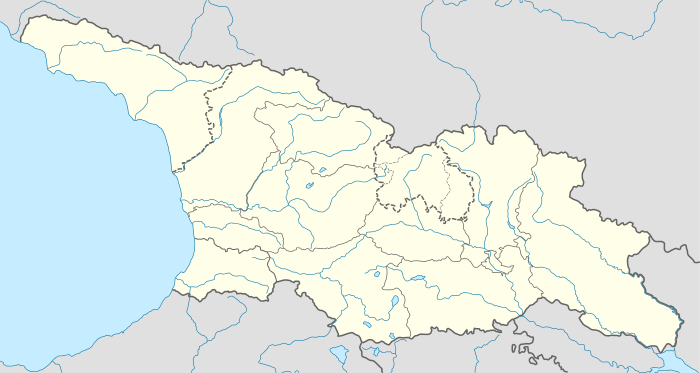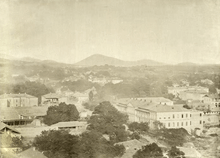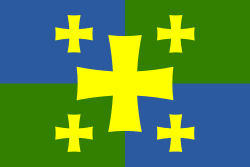Kutaisi
| Kutaisi ქუთაისი | |||
|---|---|---|---|
-cropped.jpg) | |||
| |||
 Kutaisi Location of Kutaisi in Georgia | |||
| Coordinates: 42°15′0″N 42°42′0″E / 42.25000°N 42.70000°ECoordinates: 42°15′0″N 42°42′0″E / 42.25000°N 42.70000°E | |||
| Country | Georgia | ||
| Region (Mkhare) | Imereti | ||
| Government | |||
| • Mayor | Shota Murghulia [1] | ||
| Area | |||
| • Total | 82 km2 (32 sq mi) | ||
| Population (2013) | |||
| • Total | 200,611 | ||
| Time zone | Georgian Time (UTC+4) | ||
| Climate | Cfa | ||
| Website | kutaisi.gov.ge | ||
Kutaisi (Georgian: ქუთაისი [kʰutʰɑisi]; ancient names: Aea/Aia, Kotais, Kutatisi, Kutaïsi) is the legislative capital of Georgia, and its third largest city. Situated 221 kilometres (137 miles) west of Tbilisi, it is the capital of the western region of Imereti.
Geography
Kutaisi is located along both banks of the Rioni River. The city lies at an elevation of 125–300 metres (410–984 feet) above sea level. To the east and northeast, Kutaisi is bounded by the Northern Imereti Foothills, to the north by the Samgurali Range, and to the west and the south by the Colchis Plain.
Landscape
Kutaisi is surrounded by deciduous forests to the northeast and the northwest. The low-lying outskirts of the city have a largely agricultural landscape. The city centre has many gardens its streets are lined with high, leafy trees. In the springtime, when the snow starts to melt in the nearby mountains, the storming Rioni River in the middle of the city is heard far beyond its banks.
Climate
Kutaisi has a humid subtropical climate (Cfa) with a well-defined on-shore/monsoonal flow (characteristic of the Colchis Plain) during the Autumn and Winter months. The summers are generally hot and relatively dry while the winters are wet and cool. Average annual temperature in the city is 14.5 degrees Celsius. January is the coldest month with an average temperature of 5.3 degrees Celsius while July is the hottest month with an average temperature of 23.2 degrees Celsius. The absolute minimum recorded temperature is −17 degrees Celsius and the absolute maximum is 44 degrees Celsius.
Average annual precipitation is around 1,530 mm (60.24 in). Rain may fall in every season of the year. The city often experiences heavy, wet snowfall (snowfall of 30 cm/12 inches or more per single snowstorm is not uncommon) in the winter, but the snow cover usually does not last for more than a week. Kutaisi experiences powerful easterly winds in the summer which descend from the nearby mountains.
| Climate data for Kutaisi | |||||||||||||
|---|---|---|---|---|---|---|---|---|---|---|---|---|---|
| Month | Jan | Feb | Mar | Apr | May | Jun | Jul | Aug | Sep | Oct | Nov | Dec | Year |
| Record high °C (°F) | 22 (72) |
26 (79) |
32 (90) |
34 (93) |
37 (99) |
40 (104) |
42 (108) |
40 (104) |
40 (104) |
35 (95) |
29 (84) |
25 (77) |
42 (108) |
| Average high °C (°F) | 7.7 (45.9) |
8.9 (48) |
13.1 (55.6) |
18.2 (64.8) |
23.3 (73.9) |
26.4 (79.5) |
28.1 (82.6) |
28.9 (84) |
25.8 (78.4) |
21.3 (70.3) |
15.2 (59.4) |
10.3 (50.5) |
18.9 (66) |
| Daily mean °C (°F) | 5.2 (41.4) |
5.8 (42.4) |
8.4 (47.1) |
12.9 (55.2) |
17.9 (64.2) |
21.0 (69.8) |
23.2 (73.8) |
23.6 (74.5) |
20.5 (68.9) |
16.4 (61.5) |
11.5 (52.7) |
7.5 (45.5) |
14.5 (58.1) |
| Average low °C (°F) | 1.2 (34.2) |
1.8 (35.2) |
4.6 (40.3) |
7.7 (45.9) |
12.4 (54.3) |
15.9 (60.6) |
18.9 (66) |
19.5 (67.1) |
16.1 (61) |
11.9 (53.4) |
7.5 (45.5) |
3.5 (38.3) |
10.1 (50.2) |
| Record low °C (°F) | −17 (1) |
−14 (7) |
−10 (14) |
−3 (27) |
2 (36) |
7 (45) |
10 (50) |
10 (50) |
3 (37) |
−3 (27) |
−11 (12) |
−14 (7) |
−17 (1) |
| Average precipitation mm (inches) | 106 (4.17) |
129 (5.08) |
100 (3.94) |
112 (4.41) |
85 (3.35) |
105 (4.13) |
106 (4.17) |
86 (3.39) |
116 (4.57) |
108 (4.25) |
141 (5.55) |
139 (5.47) |
1,333 (52.48) |
| Average precipitation days (≥ 0.1 mm) | 11.7 | 13.8 | 13.8 | 13.3 | 12.1 | 11.9 | 13.6 | 11.6 | 10.8 | 10.3 | 11.8 | 14.5 | 149.2 |
| Average relative humidity (%) | 68 | 68 | 69 | 66 | 69 | 72 | 76 | 75 | 74 | 71 | 65 | 64 | 70 |
| Source: Deutscher Wetterdienst[2] | |||||||||||||
History

Kutaisi was the capital of the ancient Kingdom of Colchis. Archaeological evidence indicates that the city functioned as the capital of the kingdom of Colchis in the sixth to fifth centuries BC.[3] Several historians believe that, in Argonautica, a Greek epic poem about Jason and the Argonauts and their journey to Colchis, author Apollonius Rhodius considered Kutaisi their final destination as well as the residence of King Aeëtes. From 978 to 1122 CE, Kutaisi was the capital of the united Kingdom of Georgia, and from the 15th century until 1810, it was the capital of the Imeretian Kingdom. In 1508, the city was captured by Selim I, who was the son of Bayezid II, the sultan of the Ottoman Empire.
During the seventeenth century, Imeretian kings made many appeals to Russia to help them in their struggle for independence from the Ottomans. All these appeals were ignored as Russia did not want to spoil relations with Turkey. Only in the reign of Catherine the Great, in 1768, were troops of general Gottlieb Heinrich Totleben sent to join the forces of King Heraclius II of Georgia, who hoped to reconquer the Ottoman-held southern Georgian lands, with Russian help. Totleben helped King Solomon I of Imereti to recover his capital, Kutaisi, on August 6, 1770.
Finally, the Russian-Turkish wars ended in 1810 with the annexation of the Imeretian Kingdom by the Russian Empire. The city was the capital of the Gubernia of Kutaisi, which included much of west Georgia. In March 1879, the city was the site of a blood- libel trial that attracted attention all over Russia; the ten accused Jews were acquitted.[4]
Kutaisi was a major industrial center before Georgia's independence in 1991. Independence was followed by the economic collapse of the country, and, as a result, many inhabitants of Kutaisi have had to work abroad. Small-scale trade prevails among the rest of the population.
In 2011 Mikheil Saakashvili, the president of Georgia, signed a constitutional amendment relocating the parliament to Kutaisi.[5] On 26 May 2012, Saakashvili inaugurated the new Parliament building in Kutaisi. This was done in an effort to decentralise power and shift some political control closer to Abkhazia, although it has been criticised as marginalising the legislature, and also for the demolition of a Soviet War Memorial formerly at the new building's location.[6]
Culture
Kutaisi has an ancient cultural tradition. Here is a list of the cultural centers in Kutaisi.
.jpg)
.jpg)
Museums and other cultural institutions
1. Kutaisi State Historical Museum
2. Kutaisi Museum of Sport
3. Kutaisi Museum of Martial Art
4. Museum of Zakaria Paliashvili
5. Kutaisi State Historical Archive
6. Kutaisi State Scientific-Universal Library
7. David Kakabadze Fine Art Gallery
8. Art Salon
9. Akaki Tsereteli State University
Theatres and cinema
1. Kutaisi Lado Meskhishvili State Academic Theatre
2. Kutaisi Meliton Balanchivadze State Opera House
3. Kutaisi Iakob Gogebashvili State Puppet Theatre
4. Cinema and Entertaining Center “Suliko”
5. Hermann-Wedekind-Jugendtheater
Professional unions and public organizations
- Georgian Writers’ Union
- Georgian Painters’ Union
- Folk Palace
Media
Local newspapers include: Kutaisi, Imeretis Moabe, PS, Akhali Gazeti, and Kutaisuri Versia. Other publications include Chveneburebi, a journal published by the Ministry of Diaspora Issues, and Gantiadi, a scientific journal.
TV: "Rioni"; Radio: "Dzveli Kalaki" (old City)
Also all the republican newspapers, journals and television stations have their representatives in Kutaisi.
Sport
Kutaisi has a great tradition in sports, with many famous sport clubs. FC Torpedo Kutaisi has participated on the highest level of the Soviet Union football league. After Georgia achieved independence, it won many domestic and international titles. RC AIA Kutaisi won the Soviet Championship several times in rugby, and after independence, national championships and cups. Kutaisi also had an influential basketball club BC Kutaisi 2010.
Main sights
The landmark of the city is the ruined Bagrati Cathedral, built by Bagrat III, king of Georgia, in the early 11th century. The Bagrati Cathedral, and the Gelati Monastery a few km east of the city, are UNESCO World Heritage Sites. One of the famous churches in Georgia is Motsameta Church. It is named after two saints, brothers David and Constantine. They were the Dukes of Margveti, and were martyred by Arab invaders in the 8th century. Besides the churches, there are many interesting places in Kutaisi, such as: Sataplia Cave, where one can observe footprints of dinosaurs; Geguti Palace, which was one of the residences of Georgian monarchs; "Okros Chardakhi" – Georgian Kings’ Palace; and the Pantheon, where many notable citizens are buried.
Economy
On April 2, 2009, the Georgian economy minister, Lasha Zhvania, announced that an Egypt-based home appliances producer company, Fresh Electric, intends to create a free industrial zone in Kutaisi.[7]
Transport
Airport
David the Builder Kutaisi International Airport (IATA: KUT, ICAO: UGKO) is an airport located 14 km (8.70 mi) west of Kutaisi. It is one of three international airports currently in operation in Georgia.
Railway
Kutaisi Rail Terminal has direct connection with Tbilisi (Central). Line is served by Georgian Railways.
Hotels
- Hotel Old Town - Grishashvili Str. #3/4, Kutaisi 4600;
- Aeetes Palace Hotel - Galaktion Tabidze Str. 34, Kutaisi 4600;
- Hotel Kolkha - Axalgazrdoba Avenue 38, Kutaisi 4600;
- Lux Palace Hotel - Gugunava Street 20, Kutaisi 4600;
- Hark Hotel Imeri - 25 Nikea St, Kutaisi 4600;
- Hotel Aksai - Lado Asatiani street #96, Kutaisi 4600;
- Hotel Kutaisi Globus - Solopon Pirveli Str. Kutaisi 4600;
- Discovery - Newport Street, Kutaisi 4600;
- Hotel California - 32 Jacob Gogebashvili Street, Kutaisi 4600;
- Hotel Imperator Palace - Tsminda Nino Street #31, Kutaisi 4600;
- Hostel Kutaisi by Kote - 18 Gorki Street, Kutaisi 4600;
- Tirifi Holiday - Z. Gamsaxurdia Str. #45 , Kutaisi 4600;
- Hostel Lion - Tamar Mefe Str. Kutaisi 4600;
- Bagrati 1003 - Tsereteli Str, blind alley 2-a, Kutaisi 4600;
- Hotel Continental - '''''63a, II Lane, Bukhaidze Street Kutaisi 4600;'''''
- Hotel Gora - Debi Ishkhneli Street 22, Kutaisi 4600;
- Green Flower Hotel - Gelati Str. 101, Kutaisi 4600.
Local celebrations
"Kutaisoba" is the most important holiday in Kutaisi. It is celebrated on the second of May. On this day the population of Kutaisi crowds into the central park, with their children and celebrate together. Some people make masks and there are many kinds of performances, so it is a lot of fun. Also little children sell chamomiles. It is an old tradition, in the past ladies collected money for poor people, so today children also collect money for them.
On this day one can see traditional Georgian dances and you can hear folk music. Also it is an old tradition to go in the forest, which is near Kutaisi. Families barbecue and play games. On this day, people wear traditional clothes, choxa, so you can imagine that you are in past times. Also there is a new tradition of writing lyrics which have been written by writers from Kutaisi and then airplanes throw them from the sky. There is also a competition in different kinds of martial arts.
Notable natives
- Aeëtes - King of Kingdom of Colchis
- Bagrat III - King of united Kingdom of Georgia in 975-1014
- George I - King of united Kingdom of Georgia in 1014-1027
- Bagrat IV - King of united Kingdom of Georgia in 1027-1072
- George II - King of united Kingdom of Georgia in 1072-1089
- David IV - King of united Kingdom of Georgia in 1089-1125
- Veriko Anjaparidze - Georgian actress
- Ak'ak'i Vasadze - Georgian actor
- Teimuraz Apkhazava - World and European champion in Wrestling
- Revaz Gabriadze - cinematographer, writer, director, production designer
- Niko Nikoladze (1843–1928) - Georgian public figure
- Meliton Balanchivadze (1862–1937) - Georgian composer
- Zakaria Paliashvili (1871–1933) - Georgian composer
- Iakob Nikoladze (1876–1951) - Georgian sculptor, designer of the previous state flag of Georgia.
- Władysław Raczkiewicz (1885–1947) - first president of the Polish government-in-exile, 1939–1947
- Joseph Orbeli (1887–1961) - orientalist
- David Kakabadze (1889–1952) - Georgian painter
- Victor Dolidze (1890–1933) - Georgian composer
- Otar Korkiya (1923–2005) - Georgian basketball player and coach (Olympic silver medalist as a player and European Champions' Cup winner as a coach)
- Dodo Chichinadze (1924–2009) - Georgian actress
- Revaz Dzodzuashvili (b. 1945) - Georgian football player, World Cup 1966 bronze medalist
- Zurab Sakandelidze (b. 1945) - Georgian basketball player, Olympic champion
- Mikheil Korkiya (b. 1948) - Georgian basketball player, Olympic champion
- Meir Pichhadze (1955–2010) - Israeli painter, Kutaisi native
- Tengiz Sulakvelidze (b. 1956) - Georgian football player, played in 1982 FIFA World Cup, Euro 1988 silver medalist
- Ramaz Shengelia (1957-2012) - Georgian football player, played in 1982 FIFA World Cup
- Maia Chiburdanidze (b. 1961) - the seventh Women's World Chess Champion
- Nikoloz Nemsitsveridze (b. 1963) - three-time Russian Rugby Champion with his team AIA Kutaisi
- Besik Khamashuridze (b. 1977) - Georgian rugby player, won 53 caps, RC Aia Kutaisi player-coach
- David Khakhaleishvili (b. 1971) - Olympic champion in Wrestling
- Katie Melua (b. 1984) - singer
International relations
Twin towns and sister cities
Kutaisi is twinned with:
 Ashkelon, Israel
Ashkelon, Israel Bayonne, France
Bayonne, France Columbia, MO, USA
Columbia, MO, USA Dnipropetrovsk, Ukraine
Dnipropetrovsk, Ukraine Donetsk, Ukraine
Donetsk, Ukraine Ganja, Azerbaijan[8]
Ganja, Azerbaijan[8] Gyumri, Armenia
Gyumri, Armenia Kars, Turkey
Kars, Turkey Kharkiv, Ukraine
Kharkiv, Ukraine Lviv, Ukraine
Lviv, Ukraine Newport, Wales[9]
Newport, Wales[9] Nikaia, Greece
Nikaia, Greece Plovdiv, Bulgaria
Plovdiv, Bulgaria Poznań, Poland[10]
Poznań, Poland[10] Rasht, Iran
Rasht, Iran Samsun, Turkey
Samsun, Turkey Tianjin, China
Tianjin, China Vitoria-Gasteiz, Spain
Vitoria-Gasteiz, Spain Xinhua, China
Xinhua, China
| Wikimedia Commons has media related to Kutaisi. |
See also
References
- ↑ Official Government site of Kutaisi
- ↑ "Klimatafel von Kutaisi / Georgien" (PDF). Baseline climate means (1961-1990) from stations all over the world (in German). Deutscher Wetterdienst. Retrieved 14 February 2016.
- ↑ Gela Gamkrelidze. RESEARCHES IN IBERIA-COLCHOLOGY. Edited by David Braiind (Prof, of University of Exeter (UK)) // Olar LORDKIPANIDZE CENTRE OF ARCHAEOLOGY OF GEORGIAN NATIONAL MUSEUM. P. 43 "According to the data on archaeological excavations on the Gabashvili, Dateshidze and Ukimerioni hills in Kutaisi, an urban-type settlement of the 6-5 cent. BC was found to be concentrated"
- ↑ Effie Ambler, Russian Journalism and Politics: The Career of Aleksei S. Suvorin, 1861-1881 (Detroit: Wayne State University Press, 1972: ISBN 0-8143-1461-9), p. 172.
- ↑ Relocation of Next Parliament to Kutaisi Endorsed,Civil Georgia, Tbilisi, 21 June 2011.Retrieved: 24 November 2013.
- ↑ "Georgia opens new parliament in Kutaisi, far from the capital". Washington Post. 26 May 2012. Retrieved 26 May 2012.
- ↑ Egypt-based Company Plans Free Industrial Zone in Kutaisi. Civil Georgia. April 2, 2009
- ↑ "Twin-cities of Azerbaijan". Azerbaijans.com. Retrieved 2013-08-09.
- ↑ "The two cities". Newport Kutaisi Association. Retrieved 23 August 2015.
- ↑ "Poznań - Miasta partnerskie". 1998–2013 Urząd Miasta Poznania (in Polish). City of Poznań. Archived from the original on 2013-09-23. Retrieved 2013-12-11.
External links
| Wikivoyage has a travel guide for Kutaisi. |




